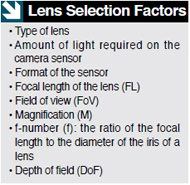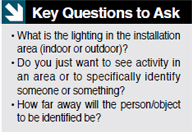Mark Wilson, VP of Marketing for Infinova, describes the differences among lenses and how to find the right one for every application.
Mark Wilson, VP of Marketing for Infinova, describes the differences among lenses and how to find the right one for every application.
After the camera, the lens is the second most important choice in a security video system. A lens is an optical device with perfect or approximate axial symmetry that refracts light, converging or diverging the beam. Manufactured lenses are typically made of glass or transparent plastic.
One o f t h e reasons l e n s e s sometimes are taken for granted is that many video cameras come with a lens already built in. So why do you need to spend so much time on the lens, since some cameras already come with one?
The answer is simple. Low-end solutions often include the camera and lens. However, in crucial applications, more appropriate solutions include the integrator's selection of a different lens for each camera based on the scene and lighting of the view.
What is a lens?
A simple lens consists of a single optical element while a compound lens is made up of an array of simple lenses with a common axis. Using multiple lenses, manufacturers can correct more optical aberrations than possible with a single lens.
The lens in a surveillance camera focuses an image of the scene onto a camera's sensor, which come in a variety of formats.
To determine specifically what lens to incorporate, users must clearly describe exactly what they want each camera to see. For example, they need to consider how far away and how wide an angle each camera needs to see.
There also is the issue of megapixel lenses for HD or megapixel cameras. When selecting a megapixel lens, you must assure that the megapixel resolution power extends across the lens's entire field of view, not just in the center.
Lenses by Application
There are many lenses used for video surveillance applications. Fixed focal length (FFL) lenses offer only one set field of view and are the least expensive. To change the resulting image, one needs to switch lenses.
Variable focal length lenses and zoom lenses offer greater flexibility, allowing one to adjust the image's field of view.
Motorized zoom lenses, the most costly type available, give you the ability to control surveillance cameras remotely. If you want to zoom-out for general surveillance and zoom-in for detail when a suspicious activity is spotted, these lenses are the best choice.
Probably the most common is a FFL lens fitted with an automatic iris. They are available in:
● wide-angle (90 degrees)
● Medium-angle (40 degrees)
● Narrow-angle (5 degrees)
FFL lenses have a single millimeter number and can be slightly less expensive than varifocal lenses. FFL lenses have a range of settings, such as 2.6 to 6 mm (wide angle), 3.5 to 8 mm (medium angle) and 5 to 50 mm (long distance). End users often standardize on varifocal lenses for their fixed cameras. Even though they cost a little more, varifocal lenses are more flexible in most situations, except where objects are a long distance away.
For such areas, motorized zoom and telephoto lenses are needed to work with fixed cameras and PTZs. They have a longer reach to hone in on specific details and are used for specialty scenes and applications.
 Aspherical lenses — high-end but not necessarily high-priced — have highly polished, computerdesigned convex surfaces that let in more light than standard lenses and hold image focus better. The technology is smaller in size, corrects for color aberration and lowers the lens f-stop number for increased light transmission.
Aspherical lenses — high-end but not necessarily high-priced — have highly polished, computerdesigned convex surfaces that let in more light than standard lenses and hold image focus better. The technology is smaller in size, corrects for color aberration and lowers the lens f-stop number for increased light transmission.
Focal Length – Camera and Lens Together
The focal length of a lens is a measure of how strongly it converges or diverges light. This is referred to as its optical power. A lens with a short focal length has greater optical power than one with a long focal length.
Focal leng t h , measured in millimeters, is the distance from the center of a lens to the sensor. The longer the focal length, the narrower is the angle of view. The shorter the focal length, the wider is the angle of view. To calculate the field of view or lens focal length of a security video camera, users need to know some parameters of the installation:
● Distance from camera to the target
● Camera installation height
● Field of view height
● Field of view width
● Camera sensor format
Field of View
Calculating the field of view (FoV) helps one select the appropriate camera (sensor format) and lens for a surveillance task. In surveillance, the FoV is that part of the scene that is visible through the camera at a particular position and orientation. The depth of field is the distance within which objects in a picture are in focus. A large or wider depth of field means almost all objects in the FoV are in focus. A small or narrow depth of field means only a small section of the FoV is in focus. Although depth of field is affected by parameters such as the focal length, the lens f-number has the most significant effect.
Objects outside the FoV are not recorded, which becomes important when gathering evidence.
Angular field of view (also called angle of view, AoV) describes the angular extent at which light can pass into a lens to create an image on the sensor. It is a function of the focal length of the lens and the dimensions of the  sensor. AoV is sometimes described using the generalized terms “wide angle” (between 60 to 100 degrees) and “telephoto” (between 10 to 15 degrees).
sensor. AoV is sometimes described using the generalized terms “wide angle” (between 60 to 100 degrees) and “telephoto” (between 10 to 15 degrees).
Although related, FoV is not exactly the same as AoV. FoV is measured in linear dimensions (feet, inches, meters); AoV is measured in degrees of arc. FoV increases with distance and changes as the camera rotates, while AoV does neither. So, while AoV is useful for lens design, FoV is more useful in designing a surveillance solution.
Don't Ignore the Lens
Selecting the right lens for the application is one of the most important tasks in designing a surveillance solution. Today, there is no technical reason why the image on a camera, network or otherwise, should not be top quality. If there are problems with the image, it is likely that the wrong lens has been selected for the application. Don't let that happen.